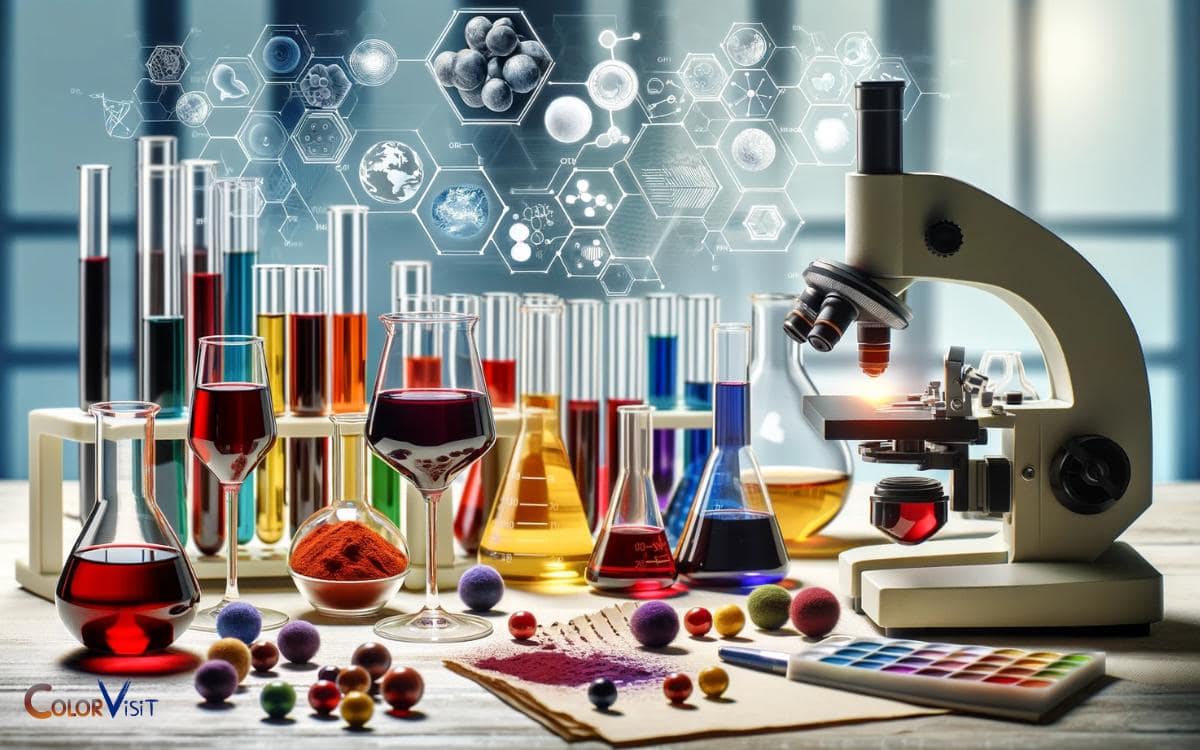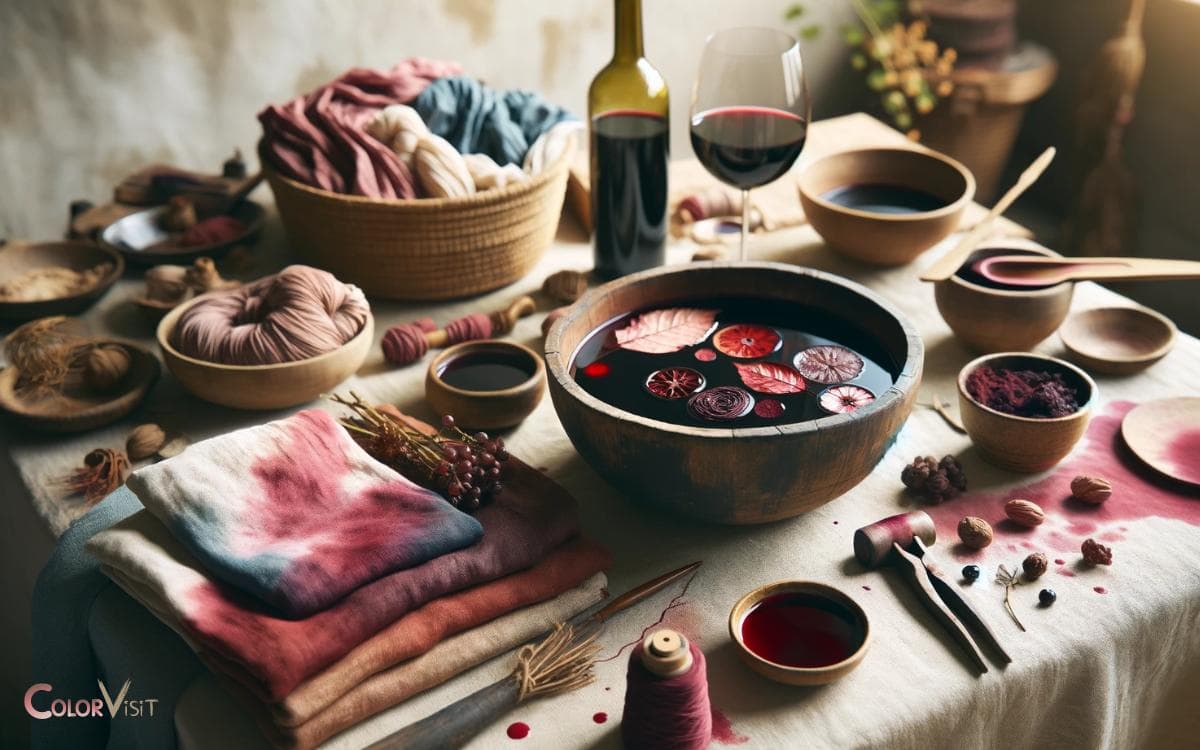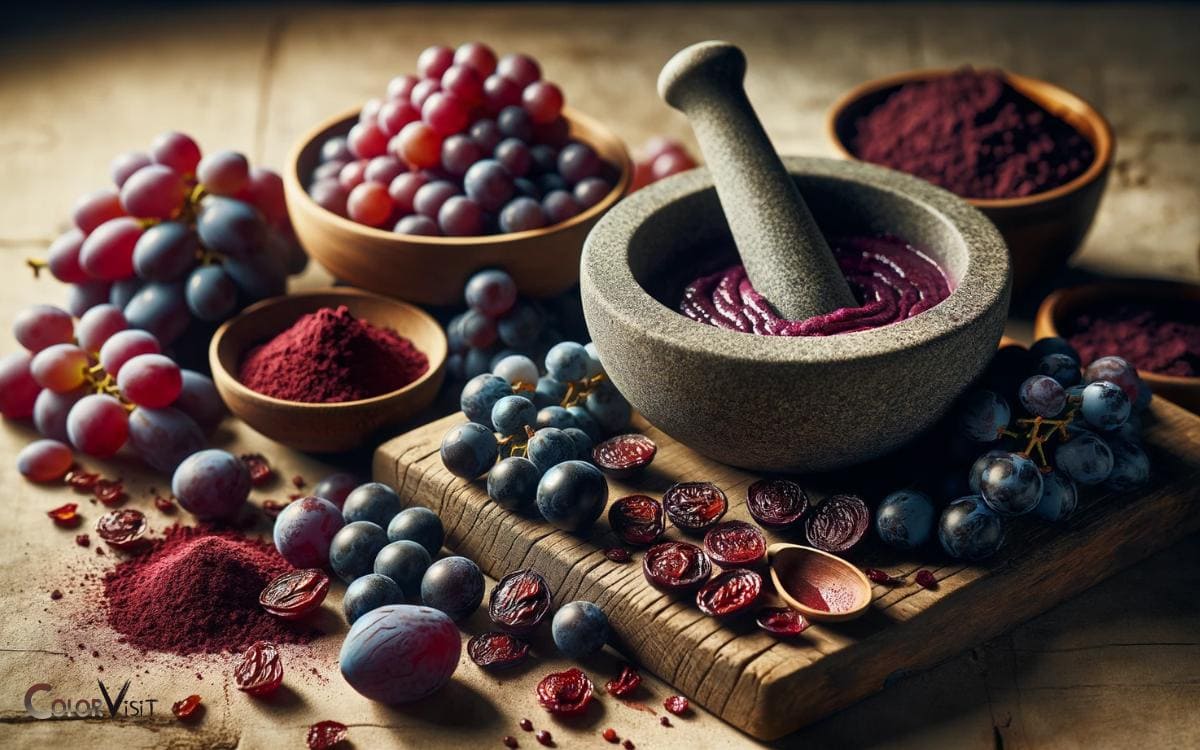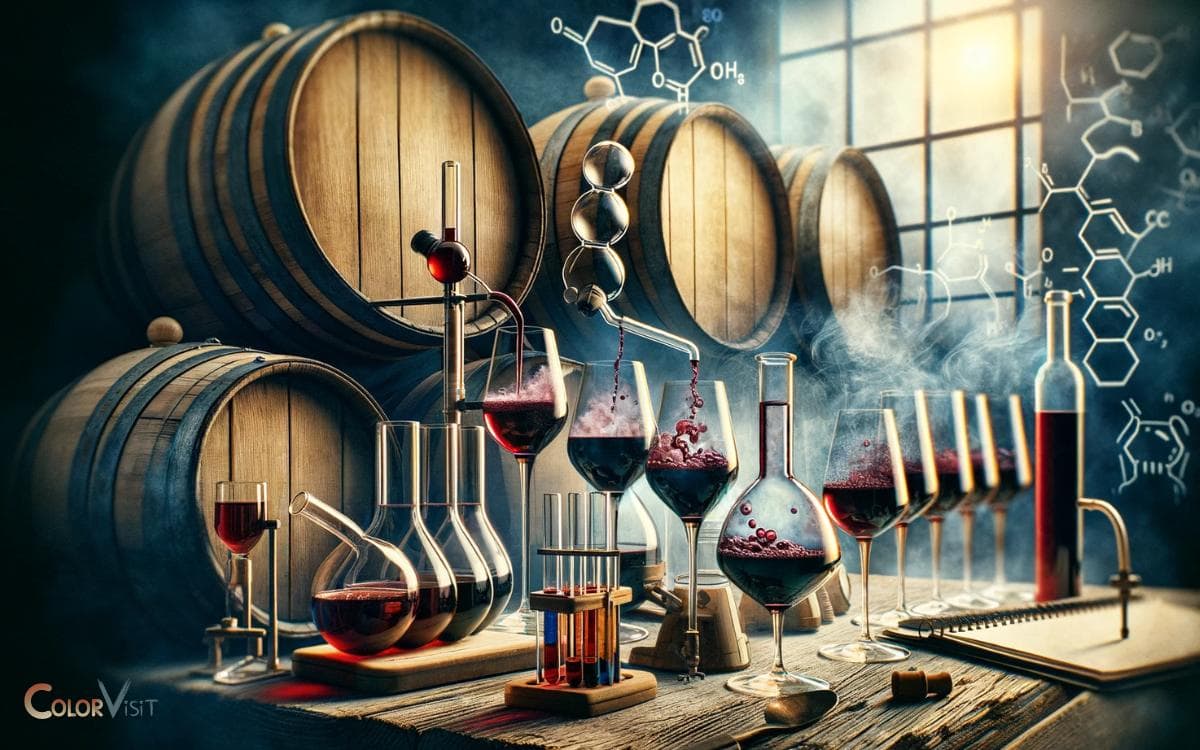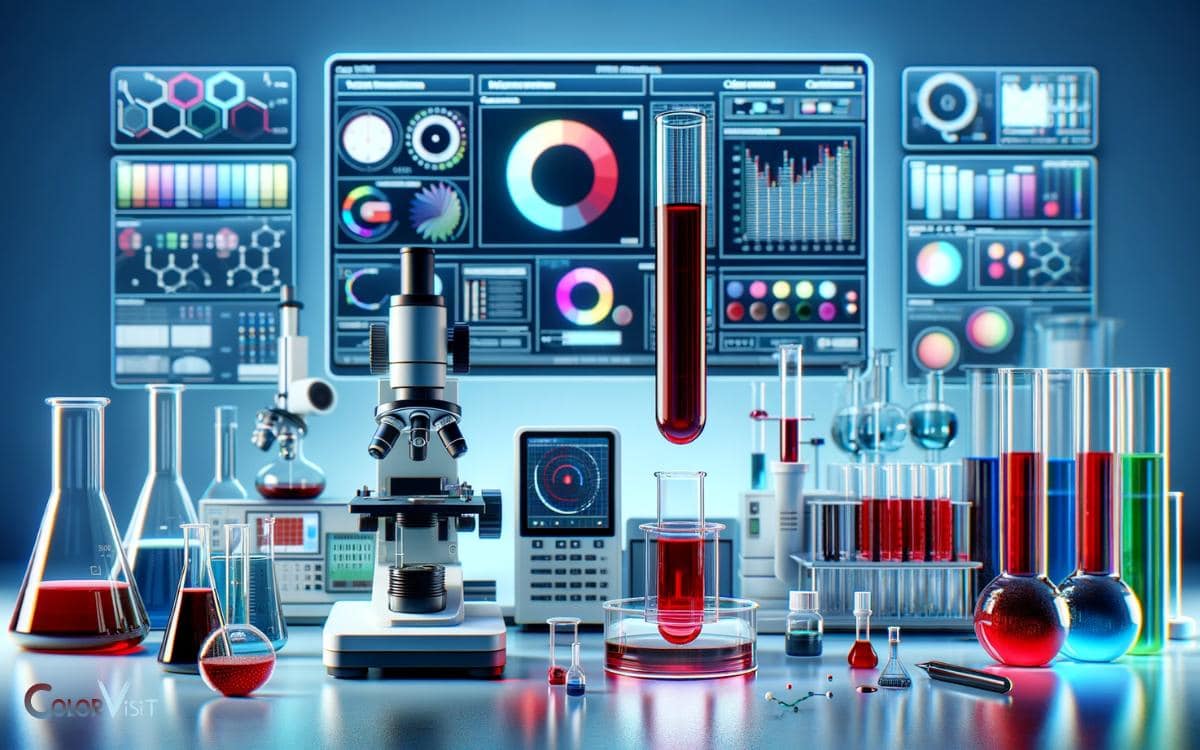How to Make Red Wine Color? 6 Steps!
To make red wine color, winemakers employ a variety of techniques including the careful selection of grape varieties, controlled fermentation processes, maceration methods to extract pigments, and aging practices.
The intensity and hue of the red color are influenced by:
Mastering the art of red wine coloration involves a symphony of precise viticulture and innovative winemaking techniques, ensuring each bottle captures the essence of its grape origins and terroir.
Key Takeaway
Step 1: Understanding the Science of Pigment Extraction
Understanding the science of pigment extraction in red wine involves comprehending the complex chemical processes that occur during maceration.
- When the grape skins are in contact with the fermenting juice, the pigments and phenolic compounds are released into the wine.
- This process is crucial for achieving the desired color and flavor profile of the red wine.
- The key compounds responsible for the color in red wine are anthocyanins, which are located in the skin of the grapes.
- During maceration, these compounds are extracted due to the alcohol present in the fermenting juice.
- The duration of maceration and the temperature at which it occurs are critical factors that influence the extent of pigment extraction.
Understanding these intricate chemical processes is essential for winemakers to consistently produce red wines of exceptional color and quality.
Step 2: Selecting the Right Wine Varietals for Color Intensity
Selecting the appropriate wine varietals for achieving optimal color intensity in red wine involves careful consideration of the grape’s pigment content and extraction potential.
- Varietals such as Cabernet Sauvignon, Petite Sirah, and Syrah are known for their deep, rich color due to higher levels of anthocyanins in their skins.
- Additionally, the thickness of the grape skin plays a crucial role in color extraction during fermentation.
- Thicker-skinned varietals like Tannat and Malbec tend to impart more intense color to the wine.
- Winemakers also consider the tannin levels, as they contribute to color stability and can enhance the perception of color intensity.
By strategically blending these varietals, winemakers can create wines with the desired color depth and vibrancy.
Step 3: Exploring Natural Dyeing Techniques With Red Wine
Red wine can be utilized as a natural dye in various textile and artistic applications.
The rich pigments found in red wine make it an intriguing option for those seeking natural dyeing techniques.
- When using red wine as a dye, it’s important to consider the fabric type and the desired color outcome.
- For lighter shades, cotton and linen fabrics are suitable choices, while wool and silk are better for achieving deeper, more intense hues.
- The process involves simmering the fabric in a mixture of red wine and water, allowing the color to slowly infuse the material.
This natural dyeing technique with red wine not only produces stunning, earthy tones but also aligns with the growing demand for sustainable and eco-friendly practices in the textile and artistic industries.
Step 4: Enhancing Color Stability Through Ph Adjustment
In the quest to enhance color stability in red wine, pH adjustment plays a crucial role. The relationship between acidity and the stability of pigments in red wine is a key factor to consider.
Ph for Color Stability
To achieve optimal color stability in red wine, it is essential to carefully adjust the pH level using precise techniques.
The pH of red wine significantly influences its color stability, making it crucial to maintain the right balance for desired color development and retention.
Here are three key factors to consider for enhancing color stability through pH adjustment:
- Acid Addition: Carefully adding tartaric, citric, or malic acid can help lower the wine’s pH, enhancing color stability by promoting anthocyanin extraction and preventing browning reactions.
- Monitoring pH Levels: Regularly monitoring the wine’s pH throughout the winemaking process is essential to ensure that the pH remains within the optimal range for color stability.
- Gentle pH Adjustment: Gradual and gentle pH adjustments should be made to avoid sudden changes that could impact the wine’s color and overall quality.
Acid and Pigments
Enhancing color stability through pH adjustment involves the careful interaction of acids with pigments in the wine, ensuring the preservation and development of the desired red wine color.
- The pH level significantly influences the color of red wine due to its impact on the stability of pigments.
- Anthocyanins, the primary pigments responsible for red wine color, exhibit different hues at varying pH levels.
- Through acid addition or reduction, winemakers can manipulate the pH to enhance color stability.
- Lowering the pH can intensify the red hue by promoting anthocyanin stability, while raising the pH can result in a more purple shade.
This delicate balance of acidity and pigment interaction is crucial in creating red wines with the desired color intensity and vibrancy, showcasing the innovative techniques employed in winemaking for optimal color development.
Color Retention Techniques
The preservation and development of the desired red wine color depend on the careful interaction of acids with pigments in the wine, ensuring color stability through pH adjustment.
To enhance color retention, winemakers employ various techniques that focus on pH adjustment:
- Monitoring pH Levels: Regular monitoring of pH levels throughout the winemaking process allows for timely adjustments to maintain color stability. This involves precise measurement and control of the acidity levels to ensure the desired hue and intensity.
- Acid Addition: Strategic addition of tartaric, malic, or citric acids can help to stabilize the color of red wine by optimizing the pH levels, thus preserving the wine’s vibrant red hue.
- Microoxygenation: Controlled exposure to oxygen during winemaking can aid in enhancing color stability, as it promotes the polymerization of pigments, contributing to richer and more stable red wine color.
Step 5: Harnessing the Power of Grape Skins and Seeds
One must harness the power of grape skins and seeds to achieve the desired red color in wine production.
- The color of red wine primarily comes from the grape skins, specifically from the presence of pigmented compounds known as anthocyanins.
- During the winemaking process, the skins are in contact with the fermenting juice, allowing the anthocyanins to leach into the wine.
- Additionally, the seeds also play a crucial role in color extraction. They contain tannins, which not only contribute to the structure and mouthfeel of the wine but also aid in color stabilization.
- Winemakers carefully manage the duration of skin contact and the techniques used to extract color and tannins from the skins and seeds, ensuring the desired hue and intensity of the red wine.
This meticulous process is essential for producing wines with vibrant and rich red hues.
Step 6: Experimenting With Aging and Oxidation for Deeper Hues
When it comes to achieving deeper hues in red wine, experimenting with aging and oxidation techniques is crucial.
Oxidation plays a key role in developing the color of red wine, while different aging techniques can contribute to the depth and richness of its hue.
Understanding how these processes impact the color of red wine is essential for winemakers looking to produce wines with the desired visual appeal and complexity.
Oxidation for Color
Experimenting with aging and oxidation is a method used to deepen the hues of red wine.
This process involves exposing the wine to controlled levels of oxygen over time, leading to chemical reactions that enhance the color and flavor profile.
Winemakers carefully monitor this oxidation process to achieve the desired color intensity and complexity.
Here are three key factors to consider when using oxidation for color enhancement:
- Oxygen exposure: Controlled exposure to oxygen is essential for achieving the desired color development without adversely affecting the wine’s overall quality.
- Time and patience: The oxidation process takes time, and patience is required to allow the wine to develop the deeper hues naturally.
- Temperature control: Maintaining consistent temperature conditions during oxidation is crucial for achieving optimal color enhancement while preserving the wine’s balance and structure.
Aging Techniques for Depth
Employing controlled aging and oxidation techniques is essential for achieving deeper hues in red wine.
- Winemakers experiment with various aging methods to enhance color depth.
- Extended maceration, where the grape skins remain in contact with the fermenting juice, allows for increased extraction of color compounds.
- Oak aging also influences color development, with the wood imparting tannins that contribute to a wine’s hue.
- Furthermore, micro-oxygenation, a controlled process that introduces small amounts of oxygen during aging, can help stabilize color compounds and enhance the wine’s overall color intensity.
- Additionally, blending different vintages or grape varieties before aging can create a more complex and deeper color profile.
By carefully manipulating these aging and oxidation variables, winemakers can achieve the desired depth and richness in red wine color, offering a spectrum of innovative options to explore.
Red Wine Hue
To achieve deeper hues in red wine, winemakers carefully manipulate aging and oxidation variables, employing controlled techniques such as extended maceration, oak aging, and micro-oxygenation.
These methods play a pivotal role in enhancing the visual appeal of red wine, contributing to its overall sensory experience.
Here’s a breakdown of these techniques:
- Extended maceration: This process involves leaving the grape skins in contact with the fermenting juice for an extended period, extracting more color and tannins, resulting in a richer hue.
- Oak aging: Aging red wine in oak barrels not only imparts flavors but also allows for controlled oxidation, leading to the development of a deeper, more complex color profile.
- Micro-oxygenation: This technique involves introducing controlled amounts of oxygen during the aging process, which can soften tannins and intensify the wine’s color, leading to a more vibrant and profound hue.
Conclusion
The process of making red wine color is a complex and intricate art. It involves understanding the science of pigment extraction and selecting the right wine varietals for color intensity.
Exploring natural dyeing techniques and enhancing color stability through pH adjustment are also important factors.
Harnessing the power of grape skins and seeds, and experimenting with aging and oxidation further contribute to the final color.
It is a delicate balance of art and science that results in the deep, rich hues that we associate with red wine.


